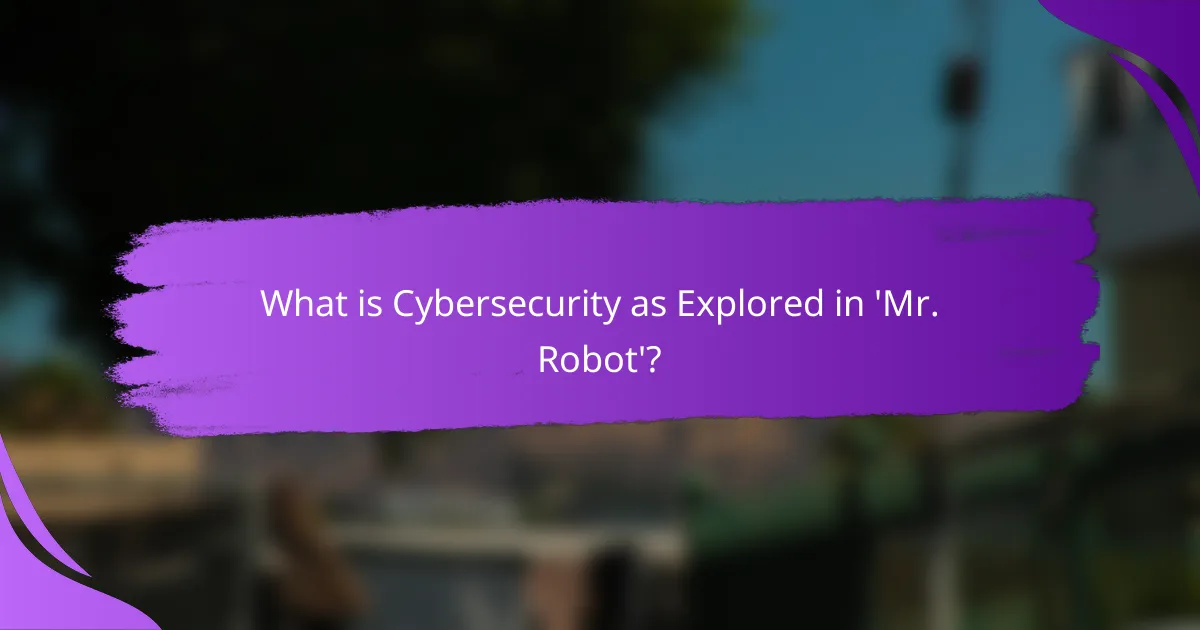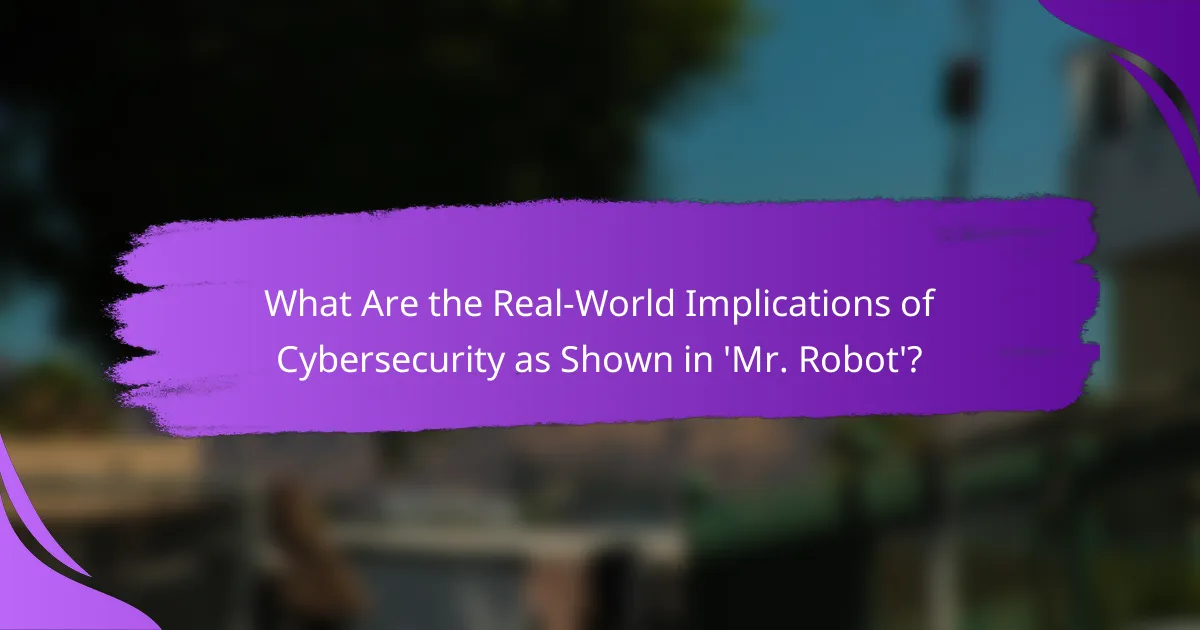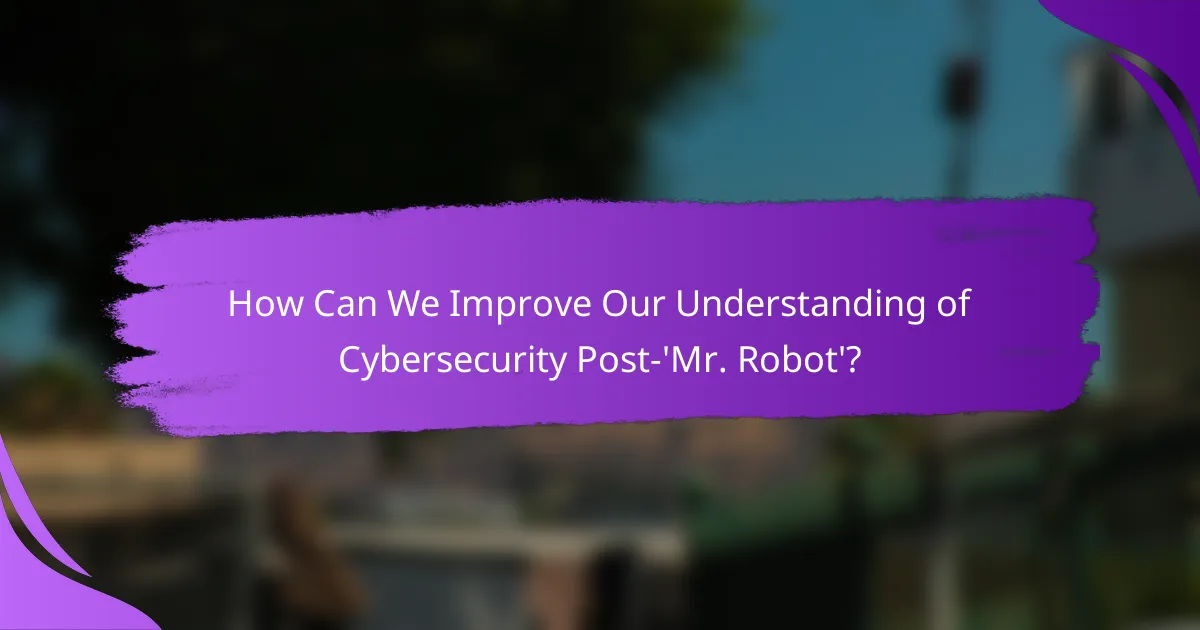The article explores the concept of cybersecurity as depicted in the television series ‘Mr. Robot.’ It examines the show’s representation of hacking techniques, social engineering, and the psychological dimensions of cybersecurity, emphasizing the vulnerabilities faced by corporations and governments in the digital landscape. Key themes include the ethical dilemmas encountered by the character Elliot Alderson and the real-world implications of cyberattacks, such as data breaches and identity theft. The article also highlights the importance of ethical hacking, robust security measures, and practical training in understanding and addressing contemporary cybersecurity challenges. Additionally, it discusses strategies for enhancing cybersecurity knowledge through industry reports and community engagement.

What is Cybersecurity as Explored in ‘Mr. Robot’?
Cybersecurity in ‘Mr. Robot’ refers to the protection of systems and networks from digital attacks. The series illustrates hacking techniques, social engineering, and the psychological aspects of cybersecurity. It highlights the vulnerabilities of corporations and governments in the digital age. The character Elliot Alderson embodies the complexities of cybersecurity professionals. He navigates ethical dilemmas while seeking justice against corrupt entities. Real-world cybersecurity threats are mirrored through the show’s plotlines. The portrayal of hacking emphasizes the impact of data breaches and privacy concerns. ‘Mr. Robot’ serves as a commentary on the importance of cybersecurity in contemporary society.
How is Cybersecurity Portrayed in ‘Mr. Robot’?
Cybersecurity in ‘Mr. Robot’ is portrayed as a complex and multifaceted domain. The show highlights the technical aspects of hacking and information security. It showcases real hacking techniques, such as social engineering and zero-day exploits. The narrative emphasizes the ethical dilemmas faced by hackers. Characters grapple with issues of privacy, surveillance, and corporate control. Real-world implications of cybersecurity threats are depicted through the storyline. The portrayal reflects the growing concerns over digital security in contemporary society. Overall, ‘Mr. Robot’ serves as a commentary on the vulnerabilities inherent in modern technology.
What are the key themes related to Cybersecurity in the series?
Key themes related to Cybersecurity in the series “Mr. Robot” include hacking ethics, social engineering, and the impact of surveillance. Hacking ethics explores the moral dilemmas faced by characters as they navigate the line between right and wrong. Social engineering highlights how human psychology can be exploited to gain unauthorized access. The impact of surveillance addresses the consequences of constant monitoring on individual privacy and freedom. These themes reflect real-world cybersecurity challenges, emphasizing the complexity of digital security. The series illustrates how personal motivations influence cybersecurity actions. Each theme is intertwined with character development, showcasing the human side of cybersecurity.
How do the characters reflect real-world cybersecurity roles?
The characters in ‘Mr. Robot’ reflect real-world cybersecurity roles through their distinct skill sets and ethical dilemmas. Elliot Alderson embodies the role of a [censured] tester and hacker. He demonstrates advanced technical skills, including social engineering and exploiting vulnerabilities. Darlene Alderson represents a younger generation of hackers who are driven by activism. She showcases the importance of collaboration in cybersecurity efforts. Mr. Robot, as a mentor figure, illustrates the complexities of ethical hacking and the moral implications of cyber warfare. The character of Irving highlights the role of corporate cybersecurity operatives, dealing with the intersection of business and security. These portrayals align with real-world cybersecurity professionals who navigate technical challenges and ethical considerations daily.
What Techniques are Used in ‘Mr. Robot’ for Cybersecurity?
‘Mr. Robot’ employs various techniques for cybersecurity, including social engineering, encryption, and network [censured] testing. Social engineering is used to manipulate individuals into divulging confidential information. Encryption techniques are demonstrated through the use of secure communication protocols. Network [censured] testing is portrayed by the characters exploiting vulnerabilities in systems to gain unauthorized access. The show also highlights the importance of anonymity through the use of Tor and VPNs. These techniques reflect real-world practices in cybersecurity and illustrate the complexities of protecting information.
What hacking techniques are depicted in the show?
The show “Mr. Robot” depicts various hacking techniques, including social engineering, SQL injection, and DDoS attacks. Social engineering involves manipulating individuals to divulge confidential information. SQL injection targets databases by inserting malicious code through input fields. DDoS attacks overwhelm servers with traffic, causing them to crash. The series illustrates these techniques with realistic scenarios, highlighting their impact on cybersecurity. For instance, the protagonist uses social engineering to gain access to sensitive data. This portrayal emphasizes the importance of awareness and security measures in the digital age.
How realistic are the cybersecurity methods shown?
The cybersecurity methods shown in ‘Mr. Robot’ are largely realistic but dramatized for effect. Many techniques, such as social engineering and network infiltration, reflect real-world practices. For example, social engineering exploits human psychology, which is a common tactic used by hackers. The show accurately portrays the use of encryption and hacking tools available in the cybersecurity community. However, some scenarios are exaggerated to enhance suspense. Realistic portrayals include the complexities of cybersecurity defenses and the constant evolution of threats. Overall, while the show captures essential elements of cybersecurity, it also simplifies or amplifies certain aspects for entertainment purposes.
What Challenges Does ‘Mr. Robot’ Highlight in Cybersecurity?
‘Mr. Robot’ highlights several key challenges in cybersecurity. These include social engineering, which manipulates individuals to gain access to sensitive information. The show also emphasizes the risks of insider threats, where trusted employees misuse their access. Additionally, it showcases the complexity of securing systems against advanced persistent threats. The portrayal of hacking techniques reflects real-world vulnerabilities in software and networks. Moreover, the series illustrates the ethical dilemmas faced by cybersecurity professionals. It demonstrates the balance between privacy and security in a digital age. Overall, ‘Mr. Robot’ brings attention to the multifaceted nature of cybersecurity challenges.
What ethical dilemmas are presented in the series?
The series ‘Mr. Robot’ presents several ethical dilemmas related to cybersecurity. One major dilemma is the conflict between privacy and security. Characters often face choices that pit individual rights against the need for collective safety. Another dilemma involves hacking for a perceived greater good versus the potential harm it causes. The series explores the morality of vigilante justice in the digital age. Additionally, it raises questions about consent in data usage and surveillance. The implications of these dilemmas reflect real-world challenges in cybersecurity ethics. These themes resonate with ongoing debates in technology and society.
How do the characters confront cybersecurity threats?
The characters confront cybersecurity threats by employing various hacking techniques and strategies. They utilize social engineering to manipulate individuals into revealing sensitive information. Additionally, they implement encryption to protect their communications from surveillance. The characters also engage in network [censured] testing to identify vulnerabilities in systems. They often collaborate to share knowledge and resources, enhancing their collective security efforts. Furthermore, they stay informed about the latest cybersecurity trends and threats to adapt their tactics. This multifaceted approach reflects real-world cybersecurity practices, emphasizing the importance of both technical skills and teamwork in combating threats.

What Are the Real-World Implications of Cybersecurity as Shown in ‘Mr. Robot’?
The real-world implications of cybersecurity as shown in ‘Mr. Robot’ highlight the vulnerabilities in modern digital infrastructure. The series illustrates how cyberattacks can disrupt essential services and compromise personal data. For instance, the hacking of E Corp demonstrates the potential for widespread financial chaos. Furthermore, the portrayal of social engineering techniques reveals how human psychology can be exploited. The show also emphasizes the importance of ethical hacking and the need for robust cybersecurity measures. Real-life incidents, such as the 2017 Equifax breach, echo the show’s themes of data breaches and identity theft. Overall, ‘Mr. Robot’ serves as a cautionary tale about the critical need for vigilance in cybersecurity practices.
How Does ‘Mr. Robot’ Reflect Current Cybersecurity Issues?
‘Mr. Robot’ reflects current cybersecurity issues by portraying realistic hacking techniques and their implications. The show illustrates social engineering tactics, such as phishing, which are prevalent in real-world cyber attacks. It also highlights the vulnerabilities of corporate networks, emphasizing the risks associated with inadequate security measures. Additionally, ‘Mr. Robot’ addresses the ethical dilemmas faced by hackers, mirroring contemporary debates on privacy and data security. The series incorporates themes of surveillance and government overreach, reflecting concerns about individual freedoms in the digital age. By showcasing the impact of cyber warfare on society, it raises awareness about the need for stronger cybersecurity practices. The show’s narrative aligns with actual events, such as data breaches and ransomware attacks, reinforcing its relevance to current cybersecurity challenges.
What parallels can be drawn between the show and actual cybersecurity incidents?
The show “Mr. Robot” depicts various cybersecurity incidents that closely mirror real-world events. The portrayal of hacking techniques in the show reflects actual methods used by cybercriminals. For instance, social engineering tactics shown in episodes align with documented cases of phishing attacks. The series also highlights the consequences of data breaches, similar to incidents like the Equifax breach in 2017. Additionally, the depiction of encryption and anonymity resonates with the use of tools like Tor in real-life cybersecurity practices. The show’s focus on corporate espionage parallels incidents involving major corporations facing cyberattacks. Overall, “Mr. Robot” serves as a dramatized reflection of the complexities and challenges in the cybersecurity landscape.
How do the show’s events influence public perception of cybersecurity?
The show’s events significantly influence public perception of cybersecurity by dramatizing its complexities and vulnerabilities. Through its narrative, “Mr. Robot” highlights the potential for hacking to disrupt everyday life. Viewers witness realistic portrayals of cyber attacks, which raise awareness of cybersecurity threats. The show illustrates the consequences of data breaches on individuals and corporations. This portrayal can lead to increased public concern about personal data security. Additionally, it fosters a sense of urgency regarding the need for robust cybersecurity measures. Research indicates that media representations can shape audience understanding of technological risks. A study by the Pew Research Center found that 64% of Americans feel they have limited control over their online data. Thus, “Mr. Robot” plays a role in shaping perceptions and prompting discussions about cybersecurity in society.
What Lessons Can Be Learned from ‘Mr. Robot’ About Cybersecurity?
‘Mr. Robot’ teaches critical lessons about cybersecurity. It emphasizes the importance of strong password management. The series showcases the risks of social engineering tactics. Viewers witness the consequences of unsecured networks and devices. It highlights the significance of encryption in protecting data. The show also demonstrates the impact of insider threats on organizations. Additionally, it illustrates the ethical dilemmas faced by hackers. These lessons underscore the need for comprehensive cybersecurity awareness and training.
What best practices for cybersecurity can be derived from the series?
Best practices for cybersecurity derived from the series include strong password management and regular updates. The series emphasizes using complex passwords and changing them frequently. Employing two-factor authentication is also highlighted as a crucial step. The importance of network security is showcased through the use of firewalls and encryption. Regularly backing up data is stressed to prevent loss from attacks. Additionally, the series advocates for employee training on recognizing phishing attempts. Monitoring system activity for unusual behavior is another key practice. These practices align with real-world cybersecurity recommendations from organizations like the Cybersecurity and Infrastructure Security Agency (CISA).
How can viewers apply lessons from ‘Mr. Robot’ to their own cybersecurity practices?
Viewers can apply lessons from ‘Mr. Robot’ to enhance their cybersecurity practices by adopting a proactive mindset. The show emphasizes the importance of understanding vulnerabilities in technology. Viewers should regularly update their software to protect against security flaws. They can also implement strong, unique passwords for different accounts. Utilizing two-factor authentication adds an extra layer of security. The series illustrates the dangers of social engineering, highlighting the need for skepticism in digital communications. Additionally, viewers should educate themselves about phishing attacks and how to recognize them. Finally, practicing good digital hygiene, such as regularly monitoring accounts for suspicious activity, is crucial. These practices can significantly reduce personal cybersecurity risks.

How Can We Improve Our Understanding of Cybersecurity Post-‘Mr. Robot’?
To improve our understanding of cybersecurity post-‘Mr. Robot’, we should analyze the show’s portrayal of hacking techniques and security vulnerabilities. The series illustrates real-world cybersecurity concepts, such as social engineering and network infiltration. Engaging with cybersecurity training programs can enhance practical skills. Reading industry reports, like the Verizon Data Breach Investigations Report, provides current threat landscape insights. Participating in online forums and discussions can foster community knowledge sharing. Additionally, hands-on experience through Capture The Flag (CTF) competitions can solidify theoretical knowledge. This multifaceted approach will deepen comprehension of cybersecurity challenges and solutions.
What resources are available for further learning about Cybersecurity?
Online courses such as those offered by Coursera and Udemy provide structured learning on cybersecurity. Books like “The Art of Deception” by Kevin Mitnick offer insights into social engineering. Websites like Cybrary and the SANS Institute provide free resources and training materials. Certifications such as CompTIA Security+ and Certified Information Systems Security Professional (CISSP) enhance professional credibility. Industry reports from organizations like Verizon and IBM detail current cybersecurity trends and threats. Forums and communities like Reddit’s r/cybersecurity foster discussion and knowledge sharing among enthusiasts.
What online courses or books are recommended for cybersecurity knowledge?
Recommended online courses for cybersecurity knowledge include “Cybersecurity Fundamentals” by edX and “Introduction to Cybersecurity” by Coursera. Notable books are “The Web Application Hacker’s Handbook” by Dafydd Stuttard and “Cybersecurity Essentials” by Charles J. Brooks. These resources provide foundational and advanced insights into cybersecurity practices. They cover essential topics such as network security, ethical hacking, and risk management. Their authors and platforms are reputable in the cybersecurity community.
How can communities engage in discussions about cybersecurity awareness?
Communities can engage in discussions about cybersecurity awareness through organized events and workshops. These gatherings provide a platform for sharing knowledge and experiences. Local organizations can host seminars featuring cybersecurity experts. Schools can incorporate cybersecurity education into their curricula. Online forums and social media groups can facilitate ongoing discussions. Community newsletters can feature articles on current cybersecurity threats. Collaboration with law enforcement can enhance awareness efforts. Research shows that community engagement increases awareness and reduces vulnerability to cyber threats.
What Practical Tips Can We Implement for Better Cybersecurity?
Use strong, unique passwords for all accounts. Passwords should include a mix of letters, numbers, and symbols. Two-factor authentication adds an extra layer of security. Regularly update software to patch vulnerabilities. Be cautious of phishing emails and links. Use a virtual private network (VPN) when accessing public Wi-Fi. Regularly back up data to prevent loss from attacks. Educate yourself and your team about cybersecurity risks and best practices.
What are the most effective strategies for personal cybersecurity?
The most effective strategies for personal cybersecurity include using strong, unique passwords and enabling two-factor authentication. Strong passwords should contain a mix of letters, numbers, and symbols. Using a password manager can help manage these passwords securely. Two-factor authentication adds an extra layer of security by requiring a second form of verification. Regularly updating software and devices is crucial to protect against vulnerabilities. Additionally, being cautious with email attachments and links can prevent phishing attacks. Using a virtual private network (VPN) when on public Wi-Fi protects data from potential interception. Finally, educating oneself about the latest cybersecurity threats enhances awareness and preparedness. According to the Cybersecurity & Infrastructure Security Agency (CISA), these practices significantly reduce the risk of personal data breaches.
How can organizations strengthen their cybersecurity posture based on insights from ‘Mr. Robot’?
Organizations can strengthen their cybersecurity posture by adopting a proactive approach to threat detection and response, as illustrated in ‘Mr. Robot’. The series emphasizes the importance of understanding the mindset of attackers. Organizations should conduct regular [censured] testing to identify vulnerabilities. This practice is crucial in simulating real-world attacks. Additionally, implementing robust encryption methods can protect sensitive data. The show highlights the risks of inadequate data protection. Training employees on cybersecurity awareness is vital. Human error is often a significant factor in breaches. Organizations should also develop an incident response plan. This plan should detail steps to take during a security incident. By following these insights from ‘Mr. Robot’, organizations can enhance their overall security framework.
The main entity of the article is cybersecurity as depicted in the television series ‘Mr. Robot’. The article explores various aspects of cybersecurity, including the portrayal of hacking techniques, ethical dilemmas, and the challenges faced by characters in the series. It highlights real-world implications of cybersecurity threats, such as data breaches and privacy concerns, while also addressing the technical methods used by characters, including social engineering and encryption. Additionally, the article discusses how the show reflects current cybersecurity issues and offers practical lessons and best practices for individuals and organizations to enhance their cybersecurity posture.